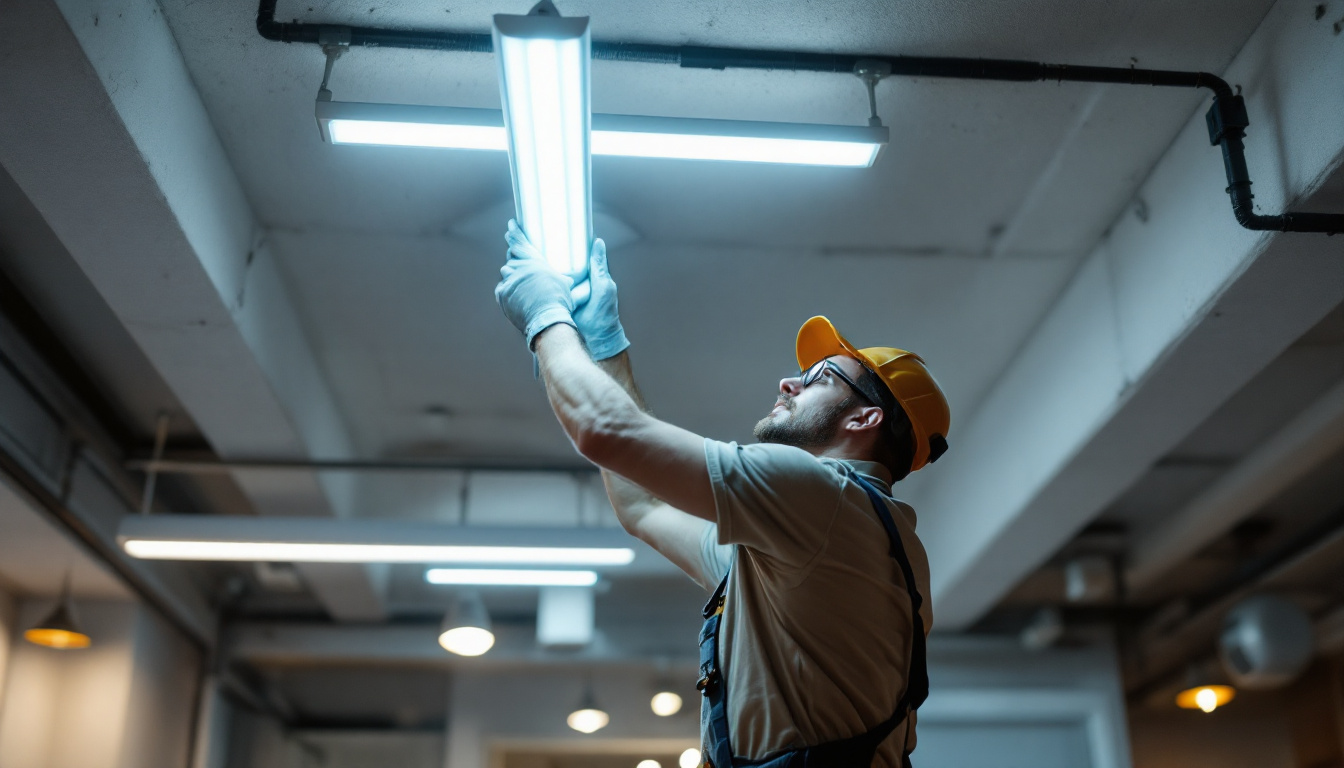
Emergency lighting plays a crucial role in ensuring safety during unforeseen circumstances, such as power outages or emergencies. For lighting contractors, understanding the functionality and significance of these systems is essential for delivering quality installations that meet safety standards.
These lights not only illuminate exit paths but also enhance the overall safety of a building. They are designed to activate automatically when the main power supply fails, providing essential visibility for occupants to evacuate safely. The reliability of emergency lighting systems is paramount, and one of the key components that ensures their functionality is the battery.
Emergency lighting systems consist of several components, including the light fixtures, control systems, and batteries. Each of these elements plays a vital role in the overall performance of the system. The batteries, in particular, are responsible for powering the lights during outages, making their maintenance and replacement critical.
Understanding the types of batteries used in these systems, such as lead-acid or lithium-ion, can help contractors make informed decisions about replacements and upgrades. Additionally, knowing the lifespan and maintenance requirements of these batteries is essential for ensuring long-term reliability. Regular testing of the batteries, as well as the entire emergency lighting system, is necessary to confirm that they function correctly when needed. This proactive approach not only safeguards the occupants but also minimizes the risk of costly repairs or replacements due to neglect.
In many regions, emergency lighting is subject to strict regulations and standards that dictate their installation and maintenance. Familiarity with these regulations is crucial for lighting contractors to ensure compliance and avoid potential liabilities. Regular inspections and timely battery replacements are often mandated by law, making it essential to incorporate these practices into the service offerings.
By adhering to regulatory standards, contractors can not only ensure the safety of occupants but also enhance their reputation as reliable service providers. This compliance can lead to increased customer trust and potentially more business opportunities. Moreover, staying updated with the latest codes and standards, such as those outlined by the National Fire Protection Association (NFPA) or local building codes, can provide contractors with a competitive edge in the market. Engaging in continuous education and training regarding emergency lighting technologies and regulations can further solidify their expertise, making them invaluable resources for clients seeking to enhance safety in their facilities.
Identifying when a battery in an emergency light needs replacement is vital for maintaining system functionality. Several indicators can signal that a battery is nearing the end of its life, and recognizing these signs can prevent unexpected failures. Emergency lighting systems are crucial for ensuring safety during power outages, and understanding the signs of battery failure can save lives.
Common signs of battery failure include dimming lights, flickering, or lights not turning on at all during a power outage. Additionally, physical signs such as swelling or leakage can also indicate battery issues. Regular testing and inspection can help contractors catch these issues early, ensuring that systems remain operational when needed most. It’s important to note that batteries can degrade over time due to factors such as temperature fluctuations and frequent discharges, which can further emphasize the need for vigilant monitoring.
Regular testing of emergency lighting systems is not only a best practice but often a legal requirement. Testing protocols typically include monthly checks of the lights and annual comprehensive tests. During these tests, contractors should verify that all lights illuminate properly and that batteries are functioning as expected. This proactive approach not only ensures compliance with safety regulations but also instills confidence in the reliability of emergency systems.
Documenting test results is also essential for compliance and can serve as evidence of due diligence in maintenance. Keeping detailed records can help contractors identify patterns of failure, allowing for proactive measures to be taken before issues escalate. Furthermore, utilizing technology such as automated testing systems can streamline this process, providing real-time data and alerts for any anomalies detected during routine checks. This integration of technology not only enhances safety but also optimizes maintenance schedules, ensuring that emergency lighting systems are always ready to perform when they are needed the most.
Changing the battery in emergency lights is a straightforward process, but it requires attention to detail to ensure safety and functionality. Here are the key steps to follow when replacing these batteries.
Before beginning the battery replacement process, it is essential to ensure that all safety measures are in place. This includes wearing appropriate personal protective equipment (PPE) and ensuring that the work area is safe. Contractors should also inform building occupants of the maintenance work to minimize disruptions.
Gathering the necessary tools and replacement batteries ahead of time can streamline the process. This preparation helps prevent delays and ensures that the replacement can be completed efficiently.
Once the area is prepared, the next step is to remove the old battery. This typically involves opening the emergency light fixture and disconnecting the battery terminals. Care should be taken to avoid damaging any wiring or components during this process.
It is advisable to inspect the old battery for any signs of corrosion or damage before disposal. Proper disposal of batteries is crucial, as they can contain hazardous materials. Following local regulations for battery disposal can help contractors maintain compliance and protect the environment.
After the old battery has been safely removed, the new battery can be installed. Ensure that the new battery is compatible with the emergency light fixture and meets the required specifications. Connecting the battery terminals securely is essential to ensure proper functionality.
Once the new battery is in place, it is important to test the emergency light to confirm that it operates correctly. This testing should include verifying that the light illuminates when the main power supply is disconnected. Documenting this test can provide valuable records for future maintenance and compliance checks.
For lighting contractors, effective maintenance of emergency lighting systems can significantly impact profitability. By implementing a proactive maintenance strategy, contractors can reduce the likelihood of emergency failures and enhance customer satisfaction.
Regular maintenance not only extends the lifespan of emergency lighting systems but also minimizes costly emergency repairs. By offering maintenance contracts to clients, contractors can establish recurring revenue streams while providing essential services that ensure safety and compliance.
Creating a maintenance schedule that outlines regular inspections and battery replacements is essential for effective management of emergency lighting systems. This schedule should consider the specific needs of each installation, including the type of battery used and the frequency of use.
Contractors can leverage technology to streamline scheduling and reminders, ensuring that maintenance tasks are completed on time. This proactive approach not only enhances system reliability but also demonstrates professionalism to clients.
Educating clients about the importance of regular maintenance for emergency lighting systems can foster stronger relationships and encourage them to invest in ongoing services. Providing information about the potential risks of neglecting maintenance can help clients understand the value of proactive measures.
Contractors can also highlight the benefits of compliance with regulations and the peace of mind that comes from knowing their emergency lighting systems are reliable. This education can lead to increased client loyalty and referrals, ultimately boosting profitability.
In today’s digital age, leveraging technology can enhance the efficiency and effectiveness of lighting installations, including emergency lighting systems. From advanced battery management systems to smart lighting controls, technology offers numerous opportunities for contractors to improve their services.
Integrating smart technology into emergency lighting systems can provide real-time monitoring and alerts for battery status and system performance. This capability allows contractors to address issues proactively, ensuring that systems are always ready for emergencies.
Smart battery management systems can provide valuable insights into battery health and performance. These systems can monitor charge cycles, temperature, and overall battery condition, allowing contractors to make informed decisions about replacements and maintenance.
By utilizing these advanced systems, contractors can optimize the lifespan of batteries and reduce the frequency of replacements, ultimately leading to cost savings and improved profitability.
Remote monitoring solutions can enhance the management of emergency lighting systems by providing real-time data on system performance. Contractors can receive alerts for battery failures or system malfunctions, allowing for swift action to be taken.
This capability not only improves response times but also enhances customer satisfaction by ensuring that systems are always operational. Clients will appreciate the added layer of reliability that comes with remote monitoring, making it a valuable selling point for contractors.
Changing batteries in emergency lights is a critical aspect of maintaining these essential safety systems. For lighting contractors, understanding the importance of regular maintenance, recognizing signs of battery failure, and implementing efficient practices can significantly impact profitability.
By developing a proactive maintenance strategy, leveraging technology, and educating clients, contractors can enhance their service offerings and build lasting relationships. Ultimately, prioritizing the reliability of emergency lighting systems not only ensures safety but also positions contractors for long-term success in the lighting industry.
Ready to elevate your lighting installations with the highest quality emergency lighting products? Look no further than LumenWholesale. Our extensive selection of spec-grade lighting solutions ensures that you can maintain the safety and compliance of your projects while maximizing profitability. With unbeatable wholesale prices and the convenience of free shipping on bulk orders, you’re guaranteed to get the best value without any hidden fees. Don’t compromise on quality or cost—choose LumenWholesale for all your lighting needs. Wholesale Lighting at the Best Value is just a click away.

Discover how lighting contractors can enhance their projects with the versatile Hanging 2 Lights Fluorescent Ho Light Fixture.

Discover how the often-overlooked electrical outlet can revolutionize your lighting designs.

Discover essential tips and techniques for lighting contractors to excel in wire connections.

Discover the pitfalls lighting contractors often face with high bay lighting installations.